It’s no secret that SEO takes time. And lots of it. No matter what SEO tactics you use.
In fact, an industry study by Ahrefs found that it takes about 3 years for a page to rank #1 in Google.
But that doesn’t mean that you need to wait months or years to see SEO results. There are a handful of SEO strategies that are highly effective – and don’t take hours to implement.
In this post I’ll cover 9 SEO tactics that only take 10 minutes (or less) to put into practice.
Let’s dive in.
1) Add Multimedia to Your Content
In my experience, adding the right multimedia can make a significant difference in your rankings.
That’s not because Google uses a page’s multimedia as a direct ranking signal. Multimedia works because it keeps users engaged on your page. Which definitely is a ranking factor that Google uses in their algorithm.
Here are just a few examples of the types of multimedia that you can add to your existing content:
- Images
- Videos
- Infographics
- Widgets
- Animated GIFs
In my experience, images and videos work best.
Like anything, the devil is in the details. So let me show you a real-life example of how to add multimedia to your content the right way. Specifically, let’s take a look at this post from the Single Grain blog: “How to Create the Ultimate Marketing Funnel (Templates Included)”.
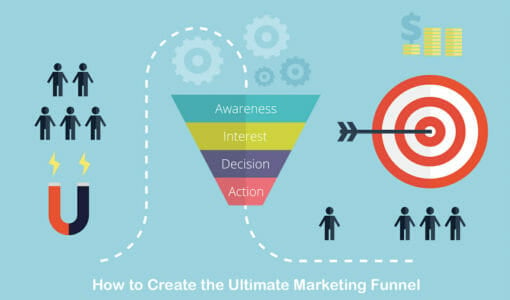
Creating a marketing funnel for the first time can be confusing. And no amount of text can really do the job alone. Which is why Eric used a number of visuals to help explain key points from the article:

But Google isn’t going to see that image and say: “That page has a cool visual. We should rank it higher.”
The reason that this visual works is that it gives searchers what they’re looking for. So they stay on the content and don’t go back to the search results. Which is exactly what Google wants to see.
Embedded videos from YouTube can also work well.
The key is to insert a video right where someone would want to learn more about something you mentioned. Almost like an external link to another site.
For example, in the same post I mentioned above, Eric embedded a video at the end of the post:

This video contains a number of real-life examples of sales funnels. Which is precisely what someone who just finished that post would want next. But instead of going back to Google to search for “funnel examples,” Eric gives that user exactly what they’re looking for right here on his page.
So not only does this SEO tactic give you a nice SEO boost, but it can also improve conversions as well.
2) Find and Fix Broken Links
Like our last SEO tactic, this one is also all about optimizing for a Google user’s UX. (Google has gone on the record saying that they don’t use broken links as a ranking factor.)
Fortunately, finding and fixing broken links is pretty easy. You can use a Google Chrome extension like Check My Links to quickly scan for broken links on a page:
The issue with that approach is that it’s tough to scale if your site has hundreds of thousands of pages.
In that case, you can use an SEO site audit tool like Screaming Frog to crawl your entire site. You can then export the broken links as a CSV file – and take 5-10 minutes to swap out any broken links that you find.
Dive Deeper: The Easy Guide to Broken Link Building for SEO
3) Optimize Your Title Tags for CTR
SEO professionals love to debate whether or not Google uses click-through rate as a ranking factor.
I personally think they do. But the funny thing is: it doesn’t really matter if Google uses CTR or not. It’s worth optimizing for either way.
In fact, boosting your site’s CTR is one of the fastest ways to get more organic traffic to your site. That’s because you really can only optimize two things, both of which only take a few minutes to change: your title tag and your meta description.
There are definitely “CTR best practices” that will usually boost your CTR, which you can read all about in this industry a while back.
For example, title tags that range between 15-40 characters tend to have the highest CTR:
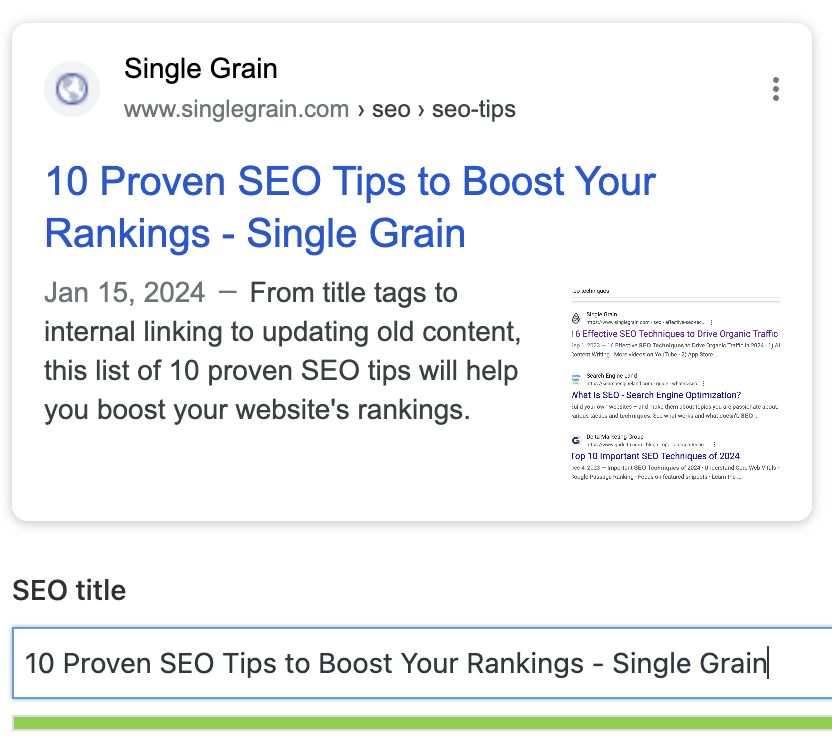
That said, you don’t just want to blindly make a bunch of changes to your title tags and hope for the best.
To get legit, long-term CTR boosts you should run controlled experiments. Specifically, record your page’s organic traffic and CTR over a long period of time (this is easy to do using Search Console). Then make your change.
And, finally, compare that page’s organic traffic and CTR to the old page. You can do this manually – in fact, that’s how I run some of my experiments.
4) Add Internal Links to a Page That Needs It
Here’s something that most SEO experts can agree on:
Internal links are an underutilized SEO tactic.
In fact, Google themselves have said that internal links can help them understand your site structure, as well as find new pages to crawl and index:
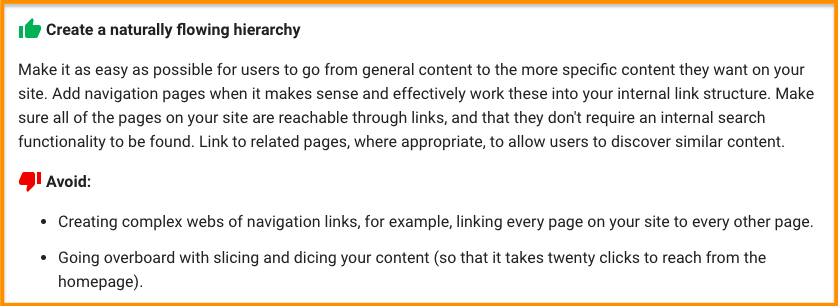
But in my experience, the #1 benefit of internal links is that they can help specific pages rank better. Especially if you funnel authority from one page to a page that you want to rank higher in Google.
For example, let’s say that you have a product page on your e-commerce site that’s important to you. Well, you can go into your blog feed, find a post that has some traction, and add a nice internal link directly to that product page.
5) Find a Trending Topic to Write About
If you’re like most people, you find topics to write about using a keyword research tool. There’s nothing wrong with that approach. Those SEO tools exist for a reason.
The issue is that many of the keywords that you come across are a) old and b) super competitive. Which is why it’s worth spending a few minutes finding keywords that are a) new and b) not competitive yet.
If you have your ear to the ground in your niche, you probably already know a few topics that are trending in your space.
For example, in the content marketing space, Core Web Vitals are one of the biggest SEO trends happening right now. Keep in mind that this isn’t a fad. Core Web Vitals are going to be a semi-permanent part of the SEO landscape. But the topic itself is growing in popularity. Plus, it’s relatively new. So keywords related to that topic aren’t that competitive yet.
I recommend spending a few minutes finding topics that are just starting to take off in your industry. If you need some inspiration, you can also use a tool like Google Trends or Exploding Topics:
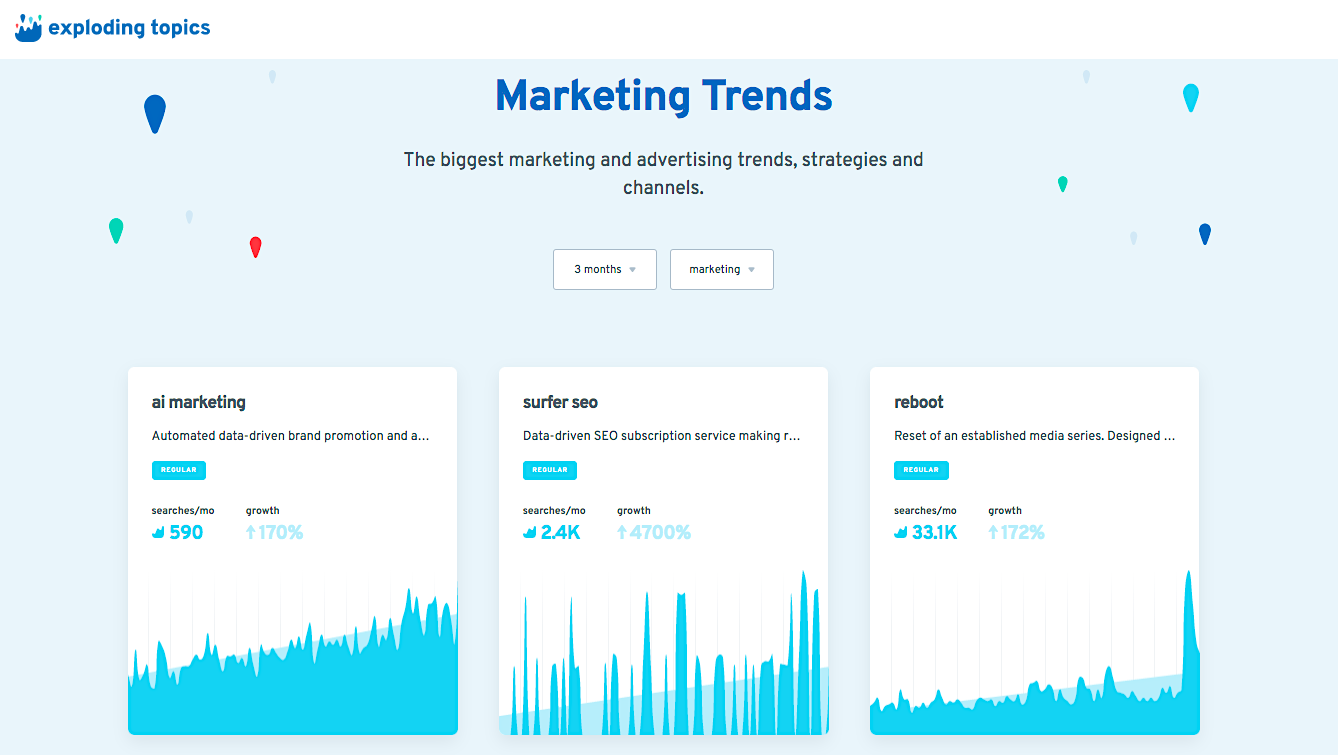
Related Content:
* How to Newsjack: A Guide for Content Marketers
* 30 Ways to Come Up with Great Ideas for Your Blog Posts
* How to Write Content for People and Optimize It for Google
6) Update an Older Blog Post
As I mentioned way back in the intro, content tends to rank better over time.
As content ages, it picks up signals that Google wants to see (namely, backlinks), which generally means that older content ranks higher than newer content.
But that’s not always the case.
This can happen if the page’s content isn’t super evergreen (basically, anything in tech and marketing). Or if the layout and design looks outdated to users.
You can prevent content decay from happening in the first place by regularly updating your content. In fact, we have a process in place at Backlinko where someone reviews each post every 6-12 months. We don’t necessarily update each post (in many cases the post is fine as-is). But if the post needs something changed (like an outdated screenshot or a technique that no longer works), we make that change.
I recommend looking at an older post on your site and just spend about 10 minutes to update anything that needs updating.
If you execute this consistently, you’ll likely find that a lot of your older content gets a second or third life. Especially if you re-promote it.
Speaking of promotion…
Dive Deeper:
* What Is Content Decay and How It Affects Your SEO
* Why You Should Update Content – Or Risk Losing The Traffic You Have [Case Study]
7) Promote Existing Content to Your Email List
When it comes to content promotion and SEO tactics, nothing beats email.
As someone who’s sent thousands of emails to my list, I can tell you firsthand that:
Email brings in way more traffic than Twitter, Facebook or any other social media network out there.
So if you have an email list, send them a quick email round-up of some of your best content. You can call this your “Content Hall of Fame” or “All-Time Best Posts.”
Or you can organize it around a specific theme. For example, you can curate 4-5 of your posts that show someone how to achieve a specific result. And send it as a “Collection of Content to Help You Get More Traffic” or “5 Steps to Bigger Biceps.”
This is a win-win. Your subscribers get to see new content that they probably missed the first time around. And you get a nice spike of traffic, shares and links to posts that were collecting digital dust.
8) Add External Links
Another one of our quick SEO tactics is external links.
The team at Reboot did a now-famous external links experiment. Their study found that websites with external links ranked higher than those without any external links:
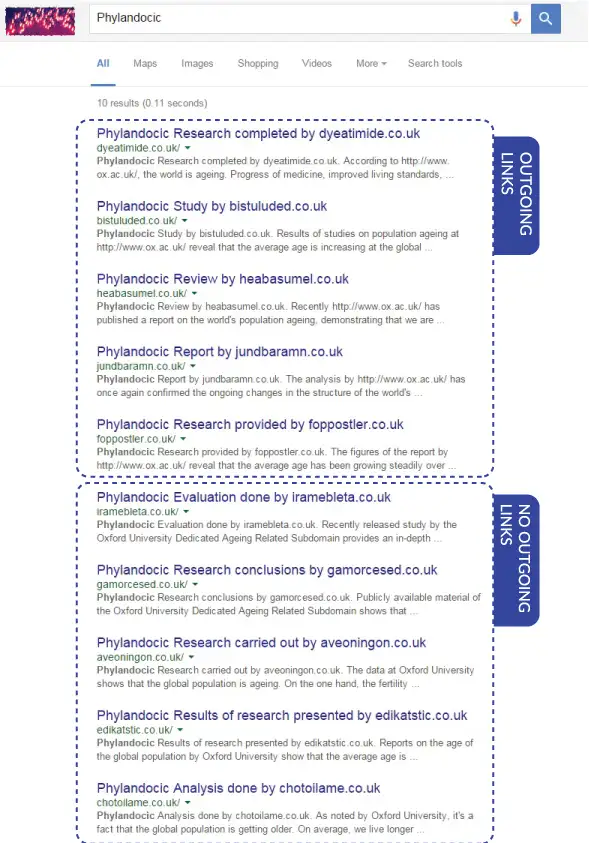
Interestingly, another SEO replicated the study in The Netherlands and found the same thing.
In short: adding external links to your page can help improve your Google rankings.
In fact, I’ve noticed the same thing from updating content on my own properties. Whenever I add external links to authoritative sites, I notice that the content usually ranks a little bit higher.
To be clear: the rankings boost is pretty minimal. But we only have 10 minutes. So what do you expect? 🙂
So yeah, this is a great SEO tactic that’s 100% worth doing. Google likely prefers to rank sites with external links because it shows that your content is well referenced. It’s impossible for a single author or site to have all the answers, so citing external sources shows Google that your content contains research. And that you curated expertise from different sources.
Also, a lot of people ask me: “Should I make the links dofollow or nofollow?” The experiments I mentioned above (and my own personal experience) have all used dofollow links.
I’ve never tested the effect of external links that are nofollowed, so I can’t say for sure if they’re treated the same way by Big G. But I am confident that external, dofollow links can make a small difference in your rankings. Which is why I recommend having your external links dofollow.
Dive Deeper:
* 8 Ways to Use External Links to Improve Your SEO
* How to Squeeze the Most Value Out of Nofollow Backlinks from High-Authority Sites
9) Look for Index Bloat Issues
Index bloat is when you have more pages indexed that you want, need or expect.
To be clear: Fixing index bloat can take way more than 10 minutes. But you can easily check to see if you have a problem in about 2 minutes.
The easiest way to spot index bloat is via Search Console. Login and click on “Coverage.” Google will show you all the pages from your site that they have indexed. They call these “Valid” pages:

This number should be approximately the total number of pages that you expect to have indexed.
For example, in my case, I want about 400 pages indexed. With random pages (like the contact page, terms of service etc.), that brings my total to 423. No worries there.
It’s perfectly OK for your indexed page total to be a little bit higher than you’d expect. But if that number was 1,000, 5,000 or 10,000, I’d know right away that I had an index bloat problem on my hands. And fixing it would be a top priority.
Dive Deeper: The Marketer’s Guide to Identifying & Fixing Google Index Bloat
Bonus: Create a List of “Vs” Terms
Everyone and their mom targets “how to” keywords. Which is why they’re increasingly competitive, despite the fact that these keywords have essentially zero commercial intent.
That’s why I’ve been focusing more on “vs” terms. As you might expect, these are keywords where people compare two different things. The great thing about “vs” terms is that most people who search for them tend to be more on the advanced side of things.
For example, a complete newbie to digital marketing might search for something like “What is digital marketing” or “How to market my business online”. These keywords have a lot of search volume. Which also means they’re competitive. Plus, people searching for those keywords probably aren’t ready to invest in whatever product or service you’re offering yet.
On the other hand, a keyword like “SEO vs PPC” or “Facebook ads vs Google ads” shows that the person is much more sophisticated about the topic.
As a bonus, unlike many how-to keywords, these terms are likely to be pretty wide open when it comes to organic competition in the SERPs.
Last Word on Quick SEO Tactics
That wraps up my list of 9 SEO tactics that only take a few minutes each to implement.
As you can see, these tactics can individually make a significant difference in your Google rankings and organic traffic. But if you take 90 minutes to execute all 9 of them, you can expect to see a noticeable impact.
So set a timer, grab a coffee and put these techniques into practice.



